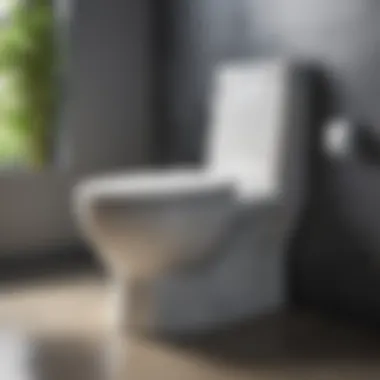Delta 1.28 GPF Toilet: Design, Efficiency, And Performance


Intro
The Delta 1.28 gallons per flush (GPF) toilet has gained attention in the home improvement industry due to its efficiency and performance. As households are increasingly becoming conscious of water consumption, selecting a low-flow toilet presents an opportunity to reduce both water usage and utility bills. This toilet combines thoughtful design with advanced flushing technology, making it a popular choice among homeowners.
Furthermore, the importance of this topic extends beyond individual households. Water conservation is critical for environmental sustainability. By understanding the benefits and performance metrics of low-flow toilets, homeowners can make informed decisions that support both their financial interests and environmental responsibility.
When discussing the Delta 1.28 GPF toilet, one must consider its features, user satisfaction, and potential issues. Each factor plays a designated role in the overall utility and impact of this fixture in a modern bathroom setting.
Preamble to Delta Toilets
The introduction of Delta toilets into the market represents a significant shift towards efficiency and sustainability in residential plumbing. This section lays the groundwork for understanding how Delta, as a brand, has positioned itself in the toilet industry, emphasizing innovation while maintaining user convenience. The commitment to environmental concerns and water conservation is particularly noteworthy in this context. Rising water costs and environmental awareness have made low-flow options more attractive for homeowners.
Delta toilets, specifically models like the 1.28 GPF, exemplify how advanced engineering can contribute to both performance and resource savings. By exploring the brand's history and technological advancements, readers will gain valuable insights into what makes Delta toilets a popular choice among home users. This section guides those seeking an efficient and reliable toilet solution, balancing modern needs with traditional comfort. Understanding the brand's evolution and its commitment to efficiency will assist in making informed decisions.
Overview of Delta as a Brand
Delta Faucet Company, founded in 1954, is a well-respected name in the plumbing industry. It is known for producing high-quality faucet and toilet products. Delta has continually adapted to changes in consumer preferences and environmental standards. The brand seeks not only to provide functional products but also aesthetically pleasing designs for modern households.
Delta toilets are built using innovative technology that enhances flushing performance while reducing water consumption. This is vital as consumers become increasingly mindful of their environmental footprint. The Delta brand stands out due to its focus on user satisfaction, nestled within a competitive market.
Evolution of Toilet Technology
The evolution of toilet technology has been remarkable. Traditional toilets used significantly more water, often exceeding 3.5 gallons per flush. The introduction of low-flow toilets in the late 20th century marked a pivotal change. Regulations were implemented to encourage the reduction of water waste in households. This created an opportunity for brands like Delta to innovate further.
Over time, advancements have led to the development of dual-flush systems, pressure-assisted flush technology, and improvements in trapway designs. Today, the Delta 1.28 GPF toilet incorporates these advancements to optimize water usage without sacrificing performance. This ongoing evolution ensures that modern toilets meet both efficiency and performance expectations, catering to eco-conscious homeowners while addressing practical needs.
Mechanics of the Delta 1. GPF Toilet
The mechanics of the Delta 1.28 gallons per flush (GPF) toilet play a crucial role in its overall efficiency and performance. Understanding how this toilet functions can help users appreciate its design and technology. This section will explore the significance of GPF ratings and how low-flow toilets operate, shedding light on the advantages and considerations that come with these features.
Understanding GPF Ratings
GPF ratings indicate the amount of water a toilet uses per flush. The Delta 1.28 GPF toilet falls into the low-flow category, meaning it uses less water than traditional toilets, which often use 3.5 to 7 GPF.
A 1.28 GPF rating reflects a commitment to water conservation without compromising performance. By using less water, households can reduce their water bills and minimize their environmental impact.
Key points regarding GPF ratings include:
- Environmental Impact: Lower GPF ratings contribute to substantial reduction in water consumption, an important factor given the growing concerns regarding water scarcity.
- Regulatory Compliance: Many regions enforce water-saving regulations, which the Delta 1.28 GPF toilet meets, making it an ideal choice for eco-conscious consumers.
- Performance Balance: Though it uses less water, the goal is to maintain effective waste removal. A well-designed 1.28 GPF toilet should still provide adequate flushing power.
How Low-Flow Toilets Operate
Low-flow toilets, including the Delta 1.28 GPF model, operate using a mix of gravity and innovative flushing technology. Unlike older models that rely solely on high water volume, low-flow toilets are designed to maximize efficiency.
The operation of a low-flow toilet can be understood through the following components:
- Flushing Mechanism: These toilets typically feature a specially designed flush valve that delivers water quickly and forcefully, ensuring all waste is cleared with minimum water use.
- Bowl Design: A water-efficient bowl design promotes smooth waste flow and helps prevent clogs, which can be a common concern among users.
- Pressure Assist Options: Some models use a pressure-assist mechanism, providing increased power during flushes while still consuming 1.28 gallons of water.
"Modern low-flow toilets can perform remarkably well, often exceeding the capabilities of older high-volume models."
To further enhance their efficiency, manufacturers like Delta implement advanced technologies and designs that work effectively with lower water volumes. Understanding how these components interact is essential when selecting a toilet that combines both effectiveness and conservation.
Environmental Considerations
Understanding the environmental aspects of the Delta 1.28 GPF toilet is crucial for both consumers and manufacturers. This section explores two significant elements: water conservation and the overall impact on water usage. Emphasizing these points reveals the toilet's role not just in homes but in broader ecological contexts.
Water Conservation Benefits
The Delta 1.28 GPF toilet exemplifies modern efficiency. By using only 1.28 gallons per flush, it saves considerable water compared to older models that can use upwards of 3.5 to 7 gallons per flush. This reduction leads to significant hydration savings. Households typically generate dozens of flushes daily, translating to thousands of gallons each year. With 1.28 GPF, families can take real strides toward sustainable living.
Benefits include:
- Lower Water Bills: Less water usage results in reduced monthly water expenses. This saving mounts over time, offsetting the initial purchase cost of the toilet.
- Conservation of Natural Resources: Lowering water consumption helps preserve local water supplies, essential especially in water-scarce areas.
- Environmental Impact: Reduced strain on municipal water systems contributes positively to overall environmental health.


As many regions face stringent water regulations, toilets like the Delta 1.28 GPF offer a practical solution to meet these standards while promoting conservation practices.
Impact on Water Usage
Examining the impact of the Delta 1.28 GPF toilet on water usage leads to a broader understanding of its benefits. The overall consumption decreases while maintaining effective waste management, which is crucial for homes and communities.
- Efficiency in Design: The design incorporates advanced flushing technology, ensuring each flush is both effective and minimized in water use. This efficiency evolves from a careful examination of user behaviors and hydraulic engineering.
- Community Implications: Widespread adoption of low-flow toilets like the Delta model alleviates pressure on local water supplies. Communities can manage their resources better, resulting in more robust ecosystem management.
- Long-Term Sustainability: Adopting water-efficient fixtures contributes to long-term sustainability goals. Think about the future: generations will benefit from today’s conservation efforts.
The Delta 1.28 GPF toilet represents a solution that balances performance with price efficiency, aiming to ensure both customer satisfaction and ecological responsibility.
"The Delta 1.28 GPF toilet is not just about individual homes; it is a part of a larger movement towards sustainable living."
This understanding plays a vital role as we explore further sections on performance metrics and user experience. The commitment to reducing water usage is not only beneficial but necessary in modern society.
Performance Metrics
Performance metrics serve as a pivotal factor when evaluating the Delta 1.28 GPF toilet. These metrics reflect not only the flushing efficiency but also the overall user satisfaction and the toilet’s environmental impact. Understanding these elements deeply informs the consumer’s purchasing decision.
Flushing Power and Efficiency
Flushing power is a core aspect in the performance of the Delta 1.28 GPF toilet. This model utilizes a combination of innovative engineering and design to create a forceful flush while consuming only 1.28 gallons per flush.
The flushing system is designed to optimize water flow and pressure, ensuring waste is effectively cleared each time. This efficiency is particularly notable if we consider older toilets that often use more than twice the water per flush with varying levels of success in waste removal. It is essential for householders to recognize that less water doesn't automatically translate to a lack of performance.
Moreover, Delta’s flush technology often incorporates features such as:
- Single flush mechanics: This simplifies operation and reduces potential mechanical failure points.
- Advanced rim design: This enhances water distribution within the bowl, maximizing the reach and effectiveness of each flush.
A reliable flushing mechanism reduces the likelihood of clogs, which can be both inconvenient and costly. The aim of this technology is to ensure that every flush is powerful enough to clear waste effectively, promoting better hygiene and lowering water bills.
User Reviews and Feedback
User experiences provide invaluable insights into the real-world performance of the Delta 1.28 GPF toilet. Reviews often highlight both the positive aspects and potential concerns associated with its use.
Many users appreciate the flushing efficiency, noting that it provides consistent performance. Customers often express satisfaction with the toilet’s low water consumption, contributing to reduced utility costs and promoting eco-friendliness. Reviews frequently comment on:
- Noise Level: Many users find the flush relatively quiet compared to older models.
- Design Aesthetics: The sleek appearance of Delta toilets receives positive feedback, making them a favored choice for modern bathrooms.
However, constructive feedback is also present. A segment of users has noted occasional issues with residual waste remaining in the bowl, which may require additional maintenance. This highlights the importance of a well-designed bowl shape.
"While I love saving water, I want to ensure that the flush is strong enough to handle everything, and for the most part, it does its job well." - A user review.
Thus, it is crucial for prospective buyers to weigh both positive and negative user experiences. Ultimately, understanding performance metrics ensures that housewives and homeowners can find a toilet that fulfills not just efficiency targets, but also performance expectations.
Installation and Maintenance
The installation and maintenance of the Delta 1.28 GPF toilet play a crucial role in maximizing its efficiency and ensuring a long-lasting performance. Proper installation can prevent common issues such as leaks and poor flushing, while regular maintenance can sustain the toilet's function over time. Both elements work hand in hand to enhance user experience and maintain the toilet's eco-friendly advantages. Understanding these components is essential for housewives and homeowners who look to invest wisely in their home plumbing solutions.
Installation Guidelines
When installing the Delta 1.28 GPF toilet, certain guidelines can lead to a successful setup. Here are several key steps to follow:
- Choose the Right Location: Ensure that the toilet is placed in a space that allows for proper drainage and access to necessary plumbing.
- Gather Necessary Tools: Collect tools such as a wrench, screwdriver, and a level to ensure accurate installation.
- Remove the Old Toilet: If replacing an old toilet, turn off the water supply, flush to empty the tank, and disconnect the water line. Remove the mounting bolts to take out the old unit.
- Install the Wax Ring: Place a new wax ring on the toilet flange. This provides a seal between the toilet and the drain.
- Position the Toilet: Carefully lower the Delta toilet onto the wax ring, aligning it with the bolts. Firmly press down to ensure a good seal.
- Secure the Toilet: Tighten the mounting nuts evenly to avoid cracking the ceramic. Use a level to confirm that the toilet is stable and balanced.
- Reconnect the Water Supply: Attach the water line back to the tank, and turn the water supply on to check for leaks. Allow the tank to fill and perform a flushing test.
Following these guidelines will help ensure a proper setup that supports the efficient functionality of the Delta toilet.
Maintenance Tips for Longevity
Maintaining the Delta 1.28 GPF toilet is vital for its durability and operational efficiency. Here are important tips:
- Regular Flushing: Flush the toilet regularly to prevent debris buildup. Consistent use can keep the internal components functioning optimally.
- Check for Leaks: Inspect periodically for leaks around the base and the water supply line. Address any leaks immediately to prevent water wastage.
- Clean the Bowl: Use a toilet bowl cleaner and brush to remove stains and build-up. Avoid harsh chemicals that could damage the toilet’s surface.
- Inspect the Flapper: Regularly check the flapper valve inside the tank. If it appears worn, replace it to prevent running water, which wastes resources.
- Maintain Water Level: Ensure that the water level in the tank is adjusted correctly. Incorrect levels can lead to inefficient flushing or even tank overflow.
Regular maintenance not only ensures the Delta toilet works correctly but can also save on water bills by preventing leaks and inefficiencies.


By adhering to these maintenance tips, the performance of the Delta 1.28 GPF toilet can be extended. Thoughtful installation and regular upkeep are key to enjoying the benefits of this efficient toilet for years to come.
Comparative Analysis
In the realm of toilet choices, conducting a comparative analysis is crucial. It enables homeowners to evaluate various options, ensuring that they make informed decisions. The Delta 1.28 GPF toilet stands out among competitors, and understanding its position requires comparing it both with traditional toilets and other low-flow brands. This section dives into the key elements that define the effectiveness and efficiency of the Delta toilet.
Delta 1. GPF vs. Traditional Toilets
The Delta 1.28 GPF toilet operates on a fundamentally different principle compared to traditional toilets. While most standard models use a higher flush volume, often around 3.5 GPF, the Delta variant uses only 1.28 gallons per flush. This marked reduction promotes significant water savings, which is increasingly important in today's environmentally conscious society.
Benefits of Delta Toilets:
- Water Conservation: The primary benefit lies in its water efficiency. By using less water per flush, households can reduce their monthly water bills.
- Performance: Despite the lower flush volume, the Delta toilet is designed to ensure effective waste removal. Advanced flushing technology helps maintain performance standards.
- Environmental Impact: With water scarcity becoming a concern globally, using a low-flow option like the Delta toilet can contribute to broader water conservation efforts.
Homeowners often seek to balance performance with savings. Many users note that the Delta 1.28 GPF models provide flushing power comparable to more water-intensive options, making them a compelling choice for those looking to upgrade.
Comparison With Other Low-Flow Brands
When examining low-flow toilets, it's essential to explore how the Delta 1.28 GPF stacks up against its competitors. Brands like Kohler, American Standard, and TOTO offer various models that also emphasize efficiency. However, differences can be found in design, price, and user satisfaction.
Key Comparison Points:
- Flushing Technology:
- Pricing:
- User Satisfaction:
- Each brand utilizes different flushing mechanisms. The Delta toilet employs a unique flushing strategy that optimizes water flow, whereas competitors may rely on standard gravity-fed systems.
- The cost can vary significantly between brands. It is crucial to assess whether the price reflects the quality and efficiency offered. Delta toilets are often competitively priced, appealing to budget-conscious consumers.
- Reviews across platforms suggest that while most low-flow toilets perform adequately, many users appreciate the seamless performance of Delta toilets compared to other brands.
Economic Factors
Understanding the economic factors related to the Delta 1.28 Gallons Per Flush (GPF) toilet is crucial for homeowners. Interest in efficient plumbing fixtures stems from both financial considerations and environmental impact. The Delta 1.28 GPF toilet notably balances cost with efficiency, making it a popular choice among homeowners striving for long-term savings.
Cost vs. Efficiency
When purchasing a toilet, the initial cost often raises questions about future savings. The Delta 1.28 GPF toilet presents an interesting case. Its performance cannot be separated from its price. While its upfront cost may be higher compared to traditional toilets, the long-term savings on water bills can justify the investment.
For instance, homes switching to lower GPF toilets often see savings of 20% to 60% on water usage. This reduction can be particularly significant in larger households or for families with increased usage.
Moreover, efficiency in water usage translates to less frequent maintenance, further reducing costs over time.
It becomes clear that in the long run, a small increase in the purchase price can yield substantial financial benefits.
Return on Investment Considerations
Investing in a Delta 1.28 GPF toilet also positions homeowners favorably in terms of property value. Modern bathrooms equipped with efficient fixtures can increase a home’s appeal. Prospective buyers often consider the long-term costs associated with older plumbing systems, which can influence purchasing decisions.
This toilet’s reputation for reliability and performance makes it an attractive feature for potential homeowners placing value on energy efficiency.
Homeowners should analyze their specific circumstances when considering the return on investment. For example,
- If water bills are high, switching may yield immediate savings.
- Homeowners intending to sell soon could benefit from an increased market value.
Understanding these elements helps buyers connect their personal needs with the broader economic benefits, further informing their decision-making.
"Investing in a water-efficient toilet not only conserves resources but also enhances the overall value of the home."
In summary, the economic implications of choosing a Delta 1.28 GPF toilet highlight the importance of considering both immediate costs and long-term benefits. This perspective allows homeowners to appreciate the full scope of their investment.
Links to further explore the topic include Wikipedia, Britannica.
Regulatory Standards
In today's market, regulatory standards are pivotal in guiding the development and efficiency of toilet technologies. These standards are designed to promote water conservation, reduce utility costs, and encourage sustainable practices among consumers. They serve as a framework for manufacturers like Delta to innovate while remaining compliant with necessary laws and guidelines.
Toilets operating under the 1.28 gallons per flush (GPF) standard have found themselves at the forefront of these regulations. Regulations are not mere suggestions but are enforced by local and federal authorities, making compliance crucial not just for manufacturers but also for homeowners. Understanding these standards can help in making informed purchasing decisions that align with both performance and environmental considerations.
Compliance with Water-Saving Regulations


Compliance with water-saving regulations ensures that toilets utilize less water per flush without compromising performance. For instance, the Efficient Use of Water Act mandates that new toilets must have a maximum flush capacity of 1.6 GPF or lower. The Delta 1.28 GPF toilet adheres to this standard, demonstrating effective flushing technology that conserves water while providing strength and efficiency.
Key benefits of compliance include:
- Reduced Water Consumption: A lower GPF means less water is used over time, leading to significant savings on water bills.
- Enhancing Sustainability: Compliance supports broader environmental goals by reducing total water usage and the burden on municipal water supply systems.
- Meeting Consumer Demands: Many consumers prioritize eco-friendly products, making compliance a selling point that aligns with market trends.
In essence, compliance ensures that a product like the Delta 1.28 GPF toilet meets a critical balance of efficiency and performance, providing peace of mind to consumers who are looking for both effectiveness in waste removal and minimal water use.
Impact of Regulations on Consumer Choices
Regulatory standards have a direct influence on how consumers make choices in the marketplace. As homeowners become more educated about the implications of their purchases, regulations serve to guide them towards products that not only perform well but also adhere to environmental guidelines.
Factors influencing consumer decisions include:
- Awareness of Water Conservation: Increasing awareness around the water crisis makes consumers more inclined to invest in low-flow toilets like the Delta 1.28 GPF model.
- Incentives and Rebates: Some local governments provide rebates for purchasing water-efficient products, thereby making compliant options more attractive.
- Perceived Value: Homeowners often associate compliance with higher quality and reliability. Toilets that meet regulatory standards are seen as better investments.
"Understanding the regulations not only helps you support sustainability but also ensures you are making a valuable choice for your home wallet."
As regulations evolve, consumers must stay informed. The choice to integrate a Delta 1.28 GPF toilet into their homes may arise not only from its efficiency but also from the assurance that it aligns with regulatory standards designed to protect our most vital resource.
User Experience Insights
User experience is essential in evaluating the Delta 1.28 GPF toilet. It goes beyond just the flushing mechanism or water efficiency; it embodies the overall interaction a user has with the product. As toilets are frequently used, the nuances of their performance can significantly influence user satisfaction and choice. Factors contributing to user experience include ease of use, comfort, aesthetics, and operational efficiency.
By analyzing user insights, potential buyers can make informed decisions. Understanding personal experiences with this toilet can highlight advantages, such as reduced water bills due to efficient flushing, alongside any potential drawbacks, like installation challenges or maintenance issues.
Moreover, insights from actual users shed light on real-life performance rather than theoretical benefits. They provide practical information that can guide consumers in selecting a toilet compatible with their lifestyle and preferences.
Feedback from Actual Users
Feedback from actual users of the Delta 1.28 GPF toilet offers invaluable perspectives. Many users appreciate the efficient flushing system, discussing how it reliably clears waste in a single flush while consuming less water compared to older models.
However, some reviews mention installation concerns. While many house owners find installation straightforward, others face challenges due to unique plumbing situations. Overall sentiment indicates that once assembled correctly, the product performs excellently.
Additionally, some users highlight the aesthetic appeal of the Delta toilet, noting its modern design. Users are piqued by the combination of functionality and visual style, helping to enhance the overall bathroom experience.
"I was surprised at how well it works! The design fits perfectly, and the water savings are noticeable. I wish I had made the switch sooner." - A satisfied user.
Common Concerns and Solutions
With any product, common concerns arise concerning usability, maintenance, and efficiency. For the Delta 1.28 GPF toilet, typical worries include flushing power, noise levels during flushing, and the need for occasional repairs. Some users express worries about reduced effectiveness in older plumbing systems.
To address flushing power, many recommend ensuring the toilet is correctly adjusted and maintained. Users can investigate whether venting issues exist in their plumbing, which can decrease effectiveness. Regular maintenance of the flushing mechanism also enhances performance.
Regarding noise, some models are designed to minimize sound. Users can explore the specific Delta toilet features that offer quieter operations, if that is a concern.
Lastly, addressing maintenance, many find clear guidelines helpful. Having a straightforward maintenance schedule can prevent minor issues from escalating into larger problems. Purchasing a warranty or service plan can also ease concerns about repairs.
Future Developments in Toilet Technology
The evolution of toilet technology does not rest on its laurels. Emerging trends indicate a shifting paradigm towards greener and more efficient solutions. As we examine the Delta 1.28 gallons per flush (GPF) toilet, understanding future developments in toilet technology becomes essential. These advancements will explore efficiency benefits and user comfort. Moreover, they will address the growing concerns associated with environmental sustainability.
Continuing to innovate, manufacturers are focusing on efficiency and functionality. These improvements can lead to reduced water usage, lower costs, and better user experiences. This indicates a shift from traditional methods to technologies that suit modern lifestyles.
Emerging Innovations
Recent advancements in toilet design offer a range of innovations that can define the future of bathroom efficiency.
- Smart Toilet Technology: Smart toilets that incorporate features such as automatic cleaning, bidet functionality, and sensor-activated flushing provide convenience alongside efficiency. The Delta 1.28 GPF toilet could benefit from these advancements, creating a more appealing overall user experience.
- Dual-Flush Systems: These toilets allow users to choose between a full flush or a reduced flush. This flexibility can lead to significant water savings without sacrificing performance. Delta and other brands are exploring this technology to enhance their product lines.
- Advanced Materials: The use of advanced ceramic or other eco-friendly materials can greatly increase durability and reduce the environmental footprint of toilet production.
These innovations not only focus on efficiency but also prioritize consumer needs. They provide an improved experience and help reduce water consumption further.
Predictions for Low-Flow Toilets
Looking ahead, the future of low-flow toilets, including the Delta 1.28 GPF model, seems promising. Expected advancements will likely focus on increasing efficiency while ensuring optimal performance.
- Water Efficiency Standards: As regulations intensify, manufacturers must adhere to stricter guidelines. This evolution will ensure that toilets not only meet the current standards but exceed them.
- Integration of Water Recycling Systems: Future toilets may feature technology for water reuse. This involves using gray water, thus expanding water conservation efforts in households.
- Refinements in Flush Performance: Further improvements in flush technology may lead to toilets that use even less water per flush while maintaining strong performance. This may address common complaints regarding low-flow toilets.
"Innovation in toilet technology is not just about convenience; it is about creating sustainable solutions for future generations."







